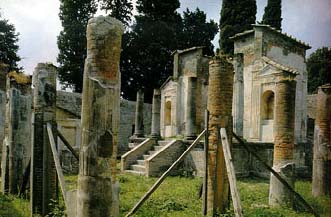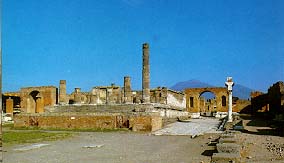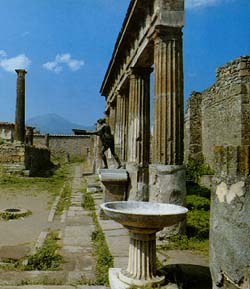
Archaeology


Archaeology
| The Temple of Isis was dedicated to the worship of the goddess from
the Egyptian triad, a cult which was spreading throughout the Roman Empire.
The cult of Isis was one of the most popular of the Mystery religions.
The temple is entered by the street named after it, Via d'Iside.
A high wall surrounding the temple hid the secret mysteries that were performed
within. The brightly painted temple faced east and stood on a raised
podium. The open cella held instruments and symbols sacred to the cult
of Isis. Two structures with niches for statues of the goddess projected
from the side. The main altar was next to the steps, and another
altar held the remains of a sacrifice. Within the sanctuary was a
cistern that held sacred waters of the Nile.
According to inscriptions, a six year old, N. Popidius Celsinus, financed the rebuilding of the Temple of Isis after its destruction in the earthquake. For his generosity he was accepted, without cost, into the town council. When the Temple of Isis was excavated in 1765, fish and eggs were found on a table. During the excavation, wall paintings, friezes, decorative objects, statuettes and symbols were removed to the National Museum of Naples. |
 |
| The Great Temple of Jupiter stands at the northern side of the Forum of Pompeii. It is a capitolium, in pure Italic style, constructed on a high base. It measures 10 feet in height, 121 feet in length, and 56 feet wide, with a double flight of stairs on the front. The vestibule is 5 columns deep. The cella, which only the priests entered, has a double order of columns around the inside, and three niches at the end, occupied by Juno, Jupiter (whose head is in the National Museum of Naples) and Minerva. Underneath the temple were rooms containing precious objects and the public treasury. The temple was built in 150 BC, and became Pompeii's main temple, when the Roman Republic took over. Seriously damaged in the earthquake of 62 AD, it was in the process of being repaired when the volcanic eruption hit Pompeii. |
 |
| The Temple of Apollo was erected by the Samnites on a site which
the Greeks had consecrated to Apollo's worship as early as the 5th century
BC. The portico, part of which we can see today, ran all around the
sacred area and the temple, and on the wall at the end of it scenes from
the Iliad were painted. A statue of Apollo on one side and opposite,
the bust of the statue of Diana, stood in front of the columns. On
the bases of the entrance portico were statues of Venus and Hermaphroditus.
The original bronzes of the Apollo and Diana statues are in Naples.
Basins for sacrificial waters were placed along the portico.
Like the Temple of Jupiter, the Temple of Apollo is of the
Italic type, with a flight of steps leading up the high base. Originally
surrounded by 28 Corinthian columns, two complete columns remain erect
on the front. An Oscan inscription on the pavement
|
 |